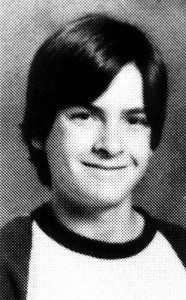 (Following is an excerpt from Dr. Herman O. Gorvald’s upcoming work, Infinite Sheen And The Recursiveness of Being, which he has generously allowed us to publish, exclusively, for the delight and edification of Stand By For Mind Control readers.)
(Following is an excerpt from Dr. Herman O. Gorvald’s upcoming work, Infinite Sheen And The Recursiveness of Being, which he has generously allowed us to publish, exclusively, for the delight and edification of Stand By For Mind Control readers.)
Medical records say Charles Foster Sheen (real name: Carlos Irwin Estévez) was born the 3rd of September, 1965, in New York, NY. More accurately, “Charlie Sheen”—actor, poet, guru, being—entered the psychic slipstream of universal consciousness not in “time”, for physics proves false time’s perceived directionality, but behind time, beside time, before time; in the all-encompassing wabe (per Carroll) of time, expanding in sympathetic centripedality with the universe itself, Charlie as gnomon, his shadow the arrow piercing our dreams, our memories, our future selves. Charlie Sheen was no more “born” than was time. He persists without beginning, without end, in a “now” not experienced but remembered, in a “then” not past but waiting to be reëxperienced for the first time, anew. Through the explication of a filmic oeuvre unique in its abrogation of both Chronos and Thanatos in favor of Dionysus, I will prove both philosophically and temporally Sheen’s preëxistence and post-corporeal unconscious re-birth into what we today “experience”, a priori, as a two-dimensional representation of human sexuality—indeed, as all human endeavor—in perpetuity, w/r/t the fundamental, so-called “dialectic of perception” we call “cinema.”
Light blasted through silver. The flickering retinal vibration. Glanglionic stimulation. Sheen. Cinema, a late 19th century invention, demanded his existence; prefigured his creation; proved his inherency; by inward extension Sheen’s somatic manifestation proves our own. Who are we but Sheen? Three million years ago, Australopithecus afrensis; one million years ago, Homo erectus; five thousand years ago, the Old Kingdom, the 4th Dynasty, Sneferu; two thousand years ago, Jesus; five hundred years ago, Shakespeare; one hundred years ago, Méliès; etcetera, etcetera; all Sheen, only Sheen. Always Sheen.
Sheen’s films—his pure self, his light—exist as ontologically self-defining matrices of cartographic conundra whose metaphysical warp and weft blanket perception, embrace it, define it; we experience the films uniquely, and in that uniqueness a universal common ground is formed. It is on this ground we stand; on it we walk; above it we rise on wings made of—what else?—pure, golden Sheen.
No film in the Sheen canon lacks salience, yet the fraction thereof I discuss below, ordered as I have ordered them, build upon one another to manifest the self-illuminating light by which inward vision gains the elastic recapitulation of outward sight; sight as vision; vision as cognizance; cognizance as Sheen. Call these films the Vital Epergne of Sheenian Mentalism; the Resonant Sheenality of Quantum Eluctation; the Zero Function of Non-Euclidean Sheenometry; or simply put:
The 10 Best Charlie Sheen Movies
10. Badlands (’73)
Boy under lamppost. Uncredited. Who among us is “credited”? Who among us has never been a “boy” under a “lamppost”? The boy is the man, the lamppost his erect phallus. Badlands is commonly—carelessly—referred to as genius director Terence Malick’s first film. It is not. It is Charlie Sheen’s first film. That he appears in it only once, as an uncredited boy under a lamppost, next to his brother, Emilio Estevez, does nothing to diminish his ownership—his authorship—of Badlands, a film ostensibly starring his own father. For Badlands is not the story of a criminal couple on the run. It is the tale of seven-year-old Charlie as Oedipus, “killing” his father by devouring his film, internalizing it, digesting it, and excreting it as a wholly formed doppelgänger of himself. Charlie’s pictorial patricide fulfills the ancient promise of Thebes. His victory is a reminder of the future past; the phallic lamppost the rocket poised to seed not one new world, but all of them.
9. Red Dawn (’84)
Wherein the rise of Communism, the threat of nuclear war, and the invasion of the American homeland are each reflected and magnified through the convex lens of Charlie Sheen’s immanent sexual powers awakening, taking wing, and penetrating the soft, moist, welcoming yoni of the universe.
Red Dawn is myopically referred to by most as just another unwatchable John Milius movie. It is not. It presents through carefully orchestrated martial mayhem a young man’s sexual destiny, vis-à-vis a subtextual if not interstitial vacuity that perceived literally, however unconsciously, denies the very power of the male member—of Sheen’s member—thrusting from Russian silos to explosively impregnate American skies with his radioactive—read: superhuman—seed. It is this power the film’s urtext demands be taken at face value.
In short, Red Dawn prefigures the post-intellectual, anti-mechanistic, retro-sexual-animism of such films as Avatar, Dances With Wolves, Leprechaun (but tellingly not Leprechaun 2), and Last Tango In Paris.
8. Young Guns (’88)
Charlie as leader, Emilio as the loose-cannon. A role reversal ripe with future portents, pregant with past echoes, bloated by metaphor; a pinguid pulling of the curtain behind which western archetypes are exploded in a cacaphony of screen idolatry gone berserk. Whereas Charlie’s death is only implied in Red Dawn, in Young Guns he is murdered, vividly, violently, as if to punish the carefree expression of sexuality marking his every past role. Like the marauding giant chicken-monster envisioned during our heroes’ peyote trip, Charlie dances the herky-jerky as he dies, tattooing on the air itself his lust for life, and his struggle not to lose it. His slayer hides—where else?—in an outhouse, his gun, i.e. his erect penis, sticking out obscenely though cracks in the door. For isn’t it through cracks that all penises wish to be stuck? Excrement is death. Here Sheen is faced with his own waste taking human form—and the form of that human’s penis—and killing him.
Young Guns—read: Virile Wieners—ride rampant across virgin territory, and in their bloody, semen-choked wake blossoms the America to come, the America of now, the America of Sheen.
7. Eight Men Out (’88) / Major League (’89)
Sheen’s critically acclaimed Baseball Duology, presciently referred to by Frederic Decaux in Cahiers de Cinema as “Not merely the first two truly ‘American’ films I have ever seen; but the only two I will ever see,” wherein the promise of Young Guns—i.e. the promise of America—is birthed. Eight Men Out is dilettantishly fancied to be the work of indie darling John Sayles. It is not. It is one hundred percent Sheen. In it, Sheen plays Happy Felsch; “happy” meaning “narcotized”, “felsch” referring to the live rabbit and cocaine-related sexual practice of the same name. To Sheen no sexual act is out of bounds. No act is out of bounds. The corruption of the Black Sox scandal stands only as metaphor. Sheen is as God; for him, everything is permitted.
“Wild Thing” Vaughn. The pitcher in Major League. Is there any other name for Sheen? His team: the Indians. From cowboy to Indian, there is only Sheen. Who do the Indians topple to advance to the final show-down of the film? The White Sox. Sheen of the present grapples with Sheen of the past. The doppelgänger reborn. The victor? Sheen.
6. Men At Work (’90)
Sheen consumed his own father at the age of 7. At the age of 25 he becomes his own brother. It is in effete parlors wittily bandied about that Emilio Estevez wrote and directed Men At Work. He did not. The internalization of the interstellar, unspoken normalization of the fraternal dyad is here linked (or wed) in as anti-figmentational, pre-structural bond, or instillment, rendering the piece emergent unsconsciously—read: consciously—from the psyche of Sheen, i.e the metatextual edifice of organic creation. He is here author; voice; seer; universal progenitor. Garbageman.
Garbage as metaphor for the dreams of all mankind, for the electric synaptic exchange of non-realized post-sexual futures driven into a collapsed state of hyperrealized extranomality. It—garbage—exists here beyond the speed of light, where the cessation of all movement—of all time—allows us to pre-visualize the redundancy of our own excrement’s desire to kill us, and to rejoice in the failure of the film’s protagonists to remove it—the thing and its desire—effectively, if at all.
We see in Men At Work Sheen responding to the plight of the common man by becoming the common man, by wearing the “costume” of the common man. Only through this transfiguration may he act to thwart the toxicity threatening to destroy everything—i.e the World—he, Sheen, has thus far fathered.
5 ½. Platoon (’86)
In which Oliver Stone uses Sheen as phallus to rape we, the viewer, and by extension, all humans throughout time. Is Sheen complicit in our forced violation? He is. It is left to us to pick up the pieces, and to arrange them into the finished puzzle that is the true state of our shared reality. This is the way Sheen laughs. If it hurts, we are to blame.
5. All Dogs Go To Heaven 2 (’96)
A decade later, the apologia. The admittance of guilt. Is it any wonder it comes in animated form? To demand this apology—and demand it we have in our ignorance—is to have willingly infantalized ourselves. Sheen, replacing Burt Reynolds in yet another Oedipal act (rumors have long-swirled in Hollywood that Reynolds was Sheen’s true father), voices Charlie B. Barkin. The setting: Heaven, contrasted with the earthbound hell of San Francisco, and finally, the prison island of Alcatraz, stolen lo these many years past from the Indians (victorious no more). As Sheen giveth, so may he taketh away.
The film was dismissed upon its release out of fear; fear to acknowlege that Sheen ruled not only on earth, but equally so in Heaven. Death is timeless; so too Sheen. The world’s religions would not allow a direct sexual assault on their dominion. Psychically, could anyone? Our proto-religious mental barricades grow stronger under attack. Coöperation with an enemy is tantamount to total corporeal absorption. Few saw the film; few who did truly “saw” it. Neuronal shocktroops waylaid the images; shot them; buried them in collective graves. But be warned: as dies the truth, so too do we. Sheen knows this. Will we listen? Are we too late?
4. Being John Malkovich (’99) / Pauly Shore Is Dead (’04) / Due Date (’10)
Charlie Sheen as—himself. Following three decades of assaying the width and breadth of human experience through his portrayal of men, women, spirits, Gods, Sheen spent the first decade of the aughts manifesting the single most daring creation of his life—Charlie Sheen. An act of obiesance? Of supplication? Of mere drollery? Or rather the destruction, once and for all, of all “art” that “preceded” him? Death to film, to theater, to poetry, to sculpture, to painting! So cries the new Sheens born in each of these films. For it is not enough that Sheen was once born, he declaims; he shall give birth to himself again! And again! For all time!
3. The Arrival (’96)
Life, death, time, religion, re-animation; they are not imbued in Sheen; Sheen is imbued in them. A form of interplanetary dictatorship must follow; dictatorship of the artistic absolute, of the omniscient permeating demigod. Such is The Arrival. It is no simplistic story of alien invasion. It is the last stand of doubt in its infinite quest to unmask the “false” Sheen. Yet no false Sheen exists. Failure is guaranteed.
The paradox of filmmaking in a reified post-Godardian “moonscape” gravitationally mediated by not one by three greater forces (see Kevlin & Moot, “Extraterrestriality In The Sheenian Microstrata,” 1998) lies in the substandard modelling precedents as “interpreted,” not originated (per A. Crumpton), a fortiori by events, vis-à-vis in casu aliens from another planet living on and terraforming the Earth. In The Arrival, the paradox is resolved by casting Ron Silver as Phil, the prime agent of the aliens. For like Sheen, Silver incorporates and adombrates a post-pre-litereral yet wholly fictive annihilation of the unreal in favor of appealing directly to the universal sense of now. Where Sheen represents the eternal good, Silver represents its anti-matter opposite. Where they meet, a universe is born; a phoenix rising from the ashes of another.
Sheen saves the Earth. Or is it that he saves from oblivion the conscious loom of creation, the fabric borne of which we’ve no choice but to wear? The boy he trusts is an alien. Implicit is this: we are all aliens, and Sheen is our leader.
2. Ferris Bueller’s Day Off (’86)
“I know what’s wrong. I just want to hear you say it.”
It is oft munificently warbled that Ferris Bueller is John Hughes’s best movie. It is not. As Sheen ate his father, his brother, Burt Reynolds and Burt Reynolds’s mustache, so too did he first internalize then externalize the physical being named John Hughes, and thus the film itself. In his role as Garth Volbeck, Sheen reiterates and reinvents the concept of acting, of living, of psychiatry, of the full extent of human emotion. The inferential dynamic at play in his single scene conforms not only to the justification of a universal omniscience, but equally to the unconditional, existential absolutism inherent in a culturally non-predicated matrix of an unbounded future.
Sheen’s black costume stands in for the black hole of his presence, into which all else falls, out of which all else is born. The film’s story—about a beloved boy whose pedagogical intransigence foretells a revolution—renders inchoate any claims to self-awareness of anyone but Volbeck, who alone avoids the two-dimensional fantasia in which the other characters are trapped, however heroically. Sheen as Volbeck is the still eye of the storm. It is we who are the wind.
1. The Chase (’94)
Finally we arrive—or is it here we began?—at the timeless classic, The Chase, a film that unfolds in so-called “real time,” ironically the one form of time in which Sheen himself has yet to take part. In The Chase Sheen steals a BMW—i.e. he single-handedly defeats the Germans in both WWI and WWII—and abducts an heiress—read: the American Dream—and drives his way to freedom. He never stops. To stop is to die. The film is metaphor for life. The American Dream falls in love with him, as he falls for the American Dream. He creates it, he loves it, he is loved by it. As the pair have sex in the moving car, they drift heavenwards, and we can almost hear the barks of Charlie B. Barkin, barks not of warning or alarm, but barks of approval, barks of contentment; the skies glow with sunset light; the car seems to fly.
A key scene in the film features corpses tumbling out of the rear of an ambulance. Each of these corpses is Sheen; each of his cinematic roles, both prior to and subsequent to The Chase, are represented by these bouncing bodies. Sheen must overcome them, and so he does, driving over and through them. Laughing, we watch this mighty hero brush past his own death.
Sheen as Charon envisions his own fiery end as The Chase winds to its conclusion, and rows us toward ours. Death as dream, death as fantasy. Sheen dies infinite deaths, ecstatic deaths, discursive deaths. Yet Sheen does not die. He chooses surrender in the film, meaning what? The fetishized abstraction of sexual congress shines through in his choice, as Sheen blends with and gives himself up to God, i.e. the non-physical pretense of presence, the inner as hypostasized other, who is none other than Sheen. This is proved when the very Dream he earlier bedded comes to his rescue. We leave them in a luxuriant realism giving lie to the “truths” we’ve throughout human history chosen to believe. In the end, the only true Truth is Sheen.
The preceding speaks for itself; I can make the matter no clearer. I leave it to Sheen himself to add the final insight, to tie these disparate strands of human history—of Sheenian history—into a single bow, with this, the key poem from his 1999 collection of poetry, A Peace Of My Mind:
A Goat In My Ass
There’s a goat in my ass,
Living mainly on grass.
They say the creature was stolen,
yet he feeds on my colon.
I don’t know how it got there,
As I burp up an occasional hair.
Often times I’ll sit and stare,
And drop pellets from my underwear.
Oh, these feelings may pass,
This wondrous goat,
In my ass.

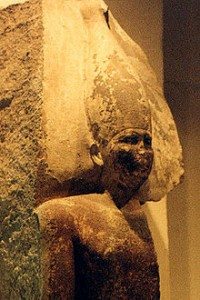
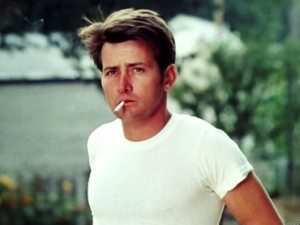
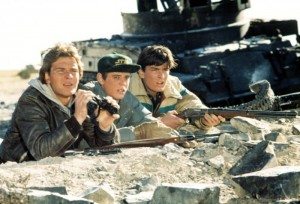
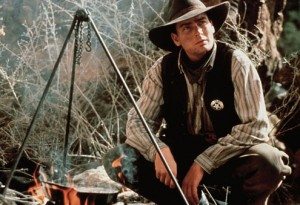
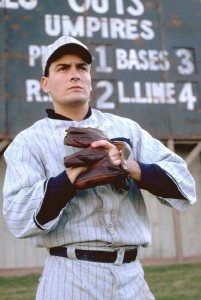
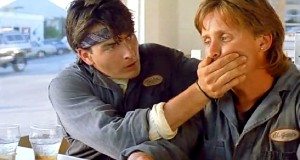

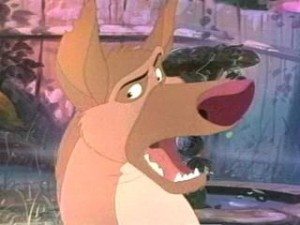
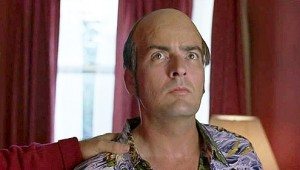
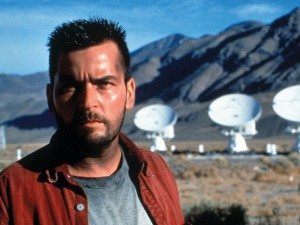
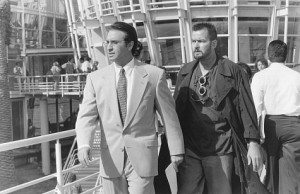

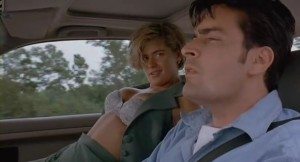
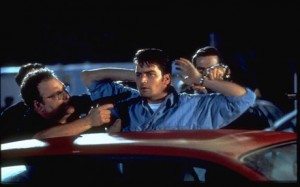
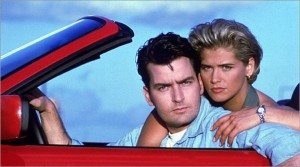
I most vociferously disagree with your highly suspect conclusions. How you have drawn any substance from a catalogue that overlooks the paramount work of Charles Sheen’s essential tragicomic übermensch terrestrial habitation is a matter for pundits to declaim from the rooftops of the internet, should the internet prove to have rooftops as Senator Scranton L. Hunphatties attested in his treatise, “Hoist from My Own Internet Rooftop Petard.”
I speak, of course, of The Wraith. This is the god-sent, third-eye-opening work in which the everlasting Sheen returns from the grave as a black-clad speedster in a demonic car, pistons churning only for vengeance, seeking and accomplishing that which man has yearned for since we inkled the mystery of the beyond, to wit; to reach out from across the skein of mortality to rend our claimant oppressors from their temporal and tangible selves. Also, to instill the luminous Sherilyn Fenn with lifeforce made fluid, purely symbolically of course.
Failing to debase oneself before The Wraith is failing to recognize that which imbues Charles Sheen with his most potent—and terrifying—means of eternal omnipresence, his tiger blood, his winning. Charles Sheen can wring from you a wholly new emotion. It is not joy. It is not sorrow. It is not irritation or flabbergast or schadenfreude or elation. It is the concurrence of all emotion, like a singularity made live within one’s own spirit, pulling all corners of the psyche together as a black hole does light. This is the Sheen. And in The Wraith, his potency cannot be ignored.
I’ve forwarded your comment do Dr. Gorvald, who comments: “I admit my reference to The Wraith may have been too shrouded in the complex metaphysics alluded to by the so-called ‘goat’ in Sheen’s ‘ass’ to have fully committed itself to outward if not literal perception, thus rendering, or, if you like, subjugating, the film in question to a seeming non-referentiality, the opposite of my intention. I grant to the commenter his point, in terms of the Universal Inkling, which by the trend in claimancy qua tangibility invested or intrinsic in argument loses the power granted by Sheen himself not only to Fenn, but to the viewer as well, and to the viewer’s pants.”
The Wraith exists to defend all that was from all that is to come. Sheen, in his supposed state of “second-generation actor,” a lie we now know, but one perpetuated at the time to lull humanity into believing that there was once a time that was not-Sheen, destroys the progeny and siblings of other actors, proving their existence to be false. The Howards, the Quaids, the Cassavetes wilt before the light of the Sheen (one would be tempted to say the Sheen’s sheen), proving their lineage inferior and unworthy to that of Sheen. Some say that in The Wraith you can see, if you are able to watch frame-by-frame, the moment when Randy Quaid was witness to his own mortality, and when his mind snapped, unable to comprehend the all-encompassing Sheen. The Wraith is the purest of all Sheen movies. He is holy avenger, living spirit and dead teen-ager. He is all things Sheen.
Amen
I’m a member of The Wraith fan site on Facebook. I am.
I am completely unsurprised by this.
I’m flattered! Wait…am I?
Beautifully scribed, sir. Pure tiger blood.
Now, will one of you please review The Place Beyond the Pines? Mind some flaws in the supporting characters and motivations; but the humanity of the film left a pit in my stomach unlike any other film has in awhile.
The Place Beyond The Pines…is that where the Log Lady lives?
It is entirely within the realm of human potentialities that one of us might see and write things about this movie. Let’s wait and see what happens…
Hahahaahahaha what a rubbish….